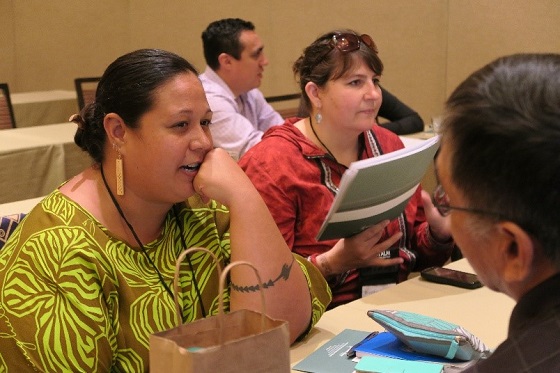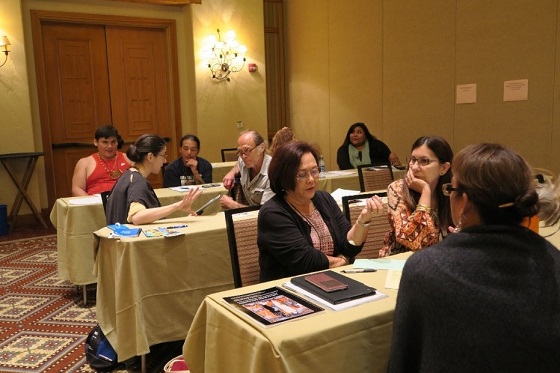Blog Posts | November 21, 2016
Share ThisEditor’s Note: Last month, IMLS staff participated in pre-conference grantee convening and other activities related to the 2016 International Conference of Indigenous Archives, Libraries, and Museums organized by the Association of Tribal Archives, Libraries, and Museums (ATALM). Office of Museum Services (OMS) staff reflect and share their learning and networking experiences in this short series of blogs.
By Sandra Narva
IMLS Senior Program Officer
Meeting with grantees to learn about the amazing work they do within their museums and cultural centers is one of my most rewarding opportunities as a Senior Program Officer. Given the great distance between many recipients and our Washington, D.C. office, face-to-face meetings are a rarity, so I consider myself honored (and lucky!) to coordinate and host a yearly gathering of current Native American/Native Hawaiian Museum Services (NANH) grant program recipients. Funds from individual awards make it possible for everyone to participate in this day of sharing and learning.
Our most recent meeting occurred October 10th, on Gila River Indian Community lands in Chandler, Ariz., with 29 participants representing 24 individual projects in attendance. The day was held as a pre-conference activity to the International Conference of Indigenous Archives, Libraries, and Museums organized by the Association of Tribal Archives, Libraries, and Museums (ATALM), and made possible in part through a Laura Bush 21st Century Librarian program award. NANH awardees also participated in conference sessions and activities, making it a full week of professional development and training centered upon the needs of administering tribal museums and cultural centers.

Prior to the meeting, all participants were asked to complete a two-page questionnaire answering several project-related questions, including if any unexpected surprises (good or bad) occurred, what challenges were encountered, and what are the next steps for the project or organization. This information was compiled and shared so everyone could learn more detailed information about all current NANH projects. After an icebreaker to get to know one another and opening comments focusing upon administering IMLS awards, the morning consisted of 10 short, 10 minute long project presentations. The diversity of topics resulted in an extremely interesting morning. For example, museum staff from the Squamish Indian Tribe of the Port Madison Reservation in Washington discussed how they coordinated the first Salish wool weavers symposium, which was so successful it is slated to become an annual event. The Tejon Indian Tribe related their efforts to create a new archaeological collections repository and research facility. Representatives from the PA’I Foundation discussed how they used grant funds to support the Mo’olelo storytelling festival – they even treated us to a “living PowerPoint” of a storytelling mele hula. The other seven projects were equally fascinating and educational, providing wonderful examples of potential activities and partnerships.
The afternoon was dedicated to several interactive activities related to grant proposal development and the future of the NANH program. Attendees participated in a grant idea generation activity where they had an opportunity to refine a project idea into the basis of an actual grant proposal. Everyone was given an opportunity to pitch a project idea to a partner to receive feedback, allowing an opportunity to polish and perfect their potential proposal. I hope we see many of these new ideas fleshed out and submitted for the next NANH program deadline on December 1.
Closing out our very full day were group activities and small group discussions focusing on the needs of tribal museums and cultural centers, and how well the NANH program meets those needs. Participants were asked to provide their top three institutional priorities before we moved on to smaller group discussions discussing the following questions: What can we do to improve the program? Are funding amounts adequate? What do we do well? What could be improved? As we enter the 13th year of offering the NANH program, this open, frank discussion resulted in thoughtful feedback for IMLS to consider and, when possible, incorporate into future program offerings.

It was an energizing and inspiring day! Bringing grantees together creates an electric environment, humming with excitement – it’s a community of practice, where those with shared interests or backgrounds learn from one another, and new connections are made. Attendees had the opportunity to network with peers they would otherwise not have an opportunity to meet.
Since 2005, the NANH program has offered grant opportunities to federally recognized tribes, Alaska Native villages and corporations, and non-profit organizations established to serve and represent Native Hawaiians. The reach of the program has been broad – 283 awards, totaling $11.5 million, have been made to tribes and Native Hawaiian organizations in 29 states. If you’re interesting in learning more about the program, please visit the NANH website.
About the Author
Sandra Narva is a senior program officer in the Office of Museum Services. She can be reached at snarva@imls.gov
